Research Results
We Can Overcome the Declining Population and Aging Society!
Diagnosing Local Governments with a Future Chart FY2018
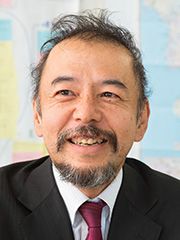
- Hidefumi Kurasaka (Professor, Graduate School of Social Sciences, Chiba University)
- RISTEX
- Designing a Sustainable Society through Intergenerational Co-creation
"Ensuring Sustainability at the Local Government Level by Promoting the Implementation of Multigenerational Participatory Stock Management Methods" Principal Investigator (2014 - 2019)
Free Future Chart issuing program hits 10,000 downloads in first 2 weeks of release
On October 30, 2017, Professor Hidefumi Kurasaka and others made the Future Chart issuing program available for free download http://opossum.jpn.org/news/data/2018/04/06/508/). By opening Excel and entering the city town village code from the included Municipality code table, the Future Chart can be obtained for the designated location.
Based on various statistical data, the Future Chart simulates parameters in roughly 10 fields, such as changes in industrial composition, and potential for sustainable management of public facilities, roads and agricultural land, and illustrates the changes for every five years in the form of a graph.
What will the town you currently live in be like in five or ten years? It can give a true sense of the impending impact of the declining and aging population on a local level.
We want that true sense to be reflected in policy formulation and so forth, and for the younger generation of residents to be involved in planning, as it is they above all else, who will carry their regions going forward. The Future Chart issuing program was researched and developed based on this kind of thinking, and within ust two weeks of its release, it surpassed the 10,000 download mark.
The coming impact of inadequate manpower can be understood at a glance from the image of the future
Japan is heading for an unprecedented situation among developed nations, a super-aging society. The population over the age of 65 years is forecast to be 33.4% in 2035; one in three people will be elderly. By 2060, the aging will have progressed to the point where 39.9% of the population is elderly. At the same time, there will be progress in the decline of the birth rate, resulting in population decline.
Along with the declining and aging population, there will be a serious lack of manpower required to support society, across fields including care, education, nursing, medical treatment, construction, agriculture, forests and fishing. Every local government will be required to establish long-term forecasts and prepare itself. However, in reality, they tend to focus on the immediate challenges facing them, and it is difficult for them to consider challenges based on the future image of the region.
Based on the evidence, the Future Chart illustrates the changes caused by inadequate manpower in the region, in an easy to understand way, with their impacts. t underscores the strengths and weaknesses of each region, serving as a basis for decisions on policy formation.
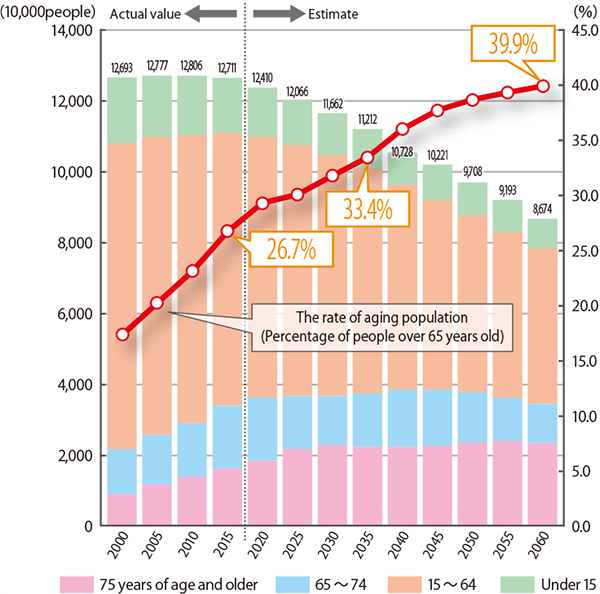
It is forecast that in Japan one in three people will be elderly by 2035. Figures to 2010 from the Population Census by the Ministry of Internal Affairs and Communications; figures for 2015 from the Population Estimates by the same Ministry, and 2020 onwards from the Population Projections for Japan by the National Institute of Population and Social Security Research.
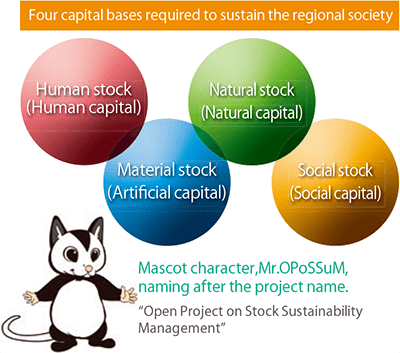
Management of capital bases that are vital to a sustainable regional society
Professor Ku rasa ka' s team have advanced research into the question of what the regional society should do in order to ensure a sustainable society, and the potential for success, in his research "Ensuring Sustainability at Local Government Level by Promoting the Implementation of Multigenerational Participatory Stock Management Methods" in the R&D focus area "Designing a Sustainable Society through I ntergenerational Co-creation". They focused on four capital bases which must be conserved over the long-term. These four bases are the capabilities of people = "human capital base," infrastructure such as hospitals, schools and roads = "artificial capital base," forests, farmlands and other environment, "natural capital base" and collaborative relationships between people = "social capital base."
How then, do we sustain, manage and use these bases? It was thought necessary for there to be management, and a manual for how to deal with it. As part of the research project, Professor Ku rasaka' steam creat-ed a database using various statistical data and various regional condi-tions, then began future prediction simulations based on that data in an easy to understand form. The fruit of this work, eventually, was the Future Chart.
Future Workshop to encourage middle-and-high school students to think about their region
In this research project, we held a "Future Workshop" to engage in discussion based on the prediction results of the Future Chart for the towns lived in by the middle- and high-school students who will carry the future of their regions, and proposed a policy to resolve the issues. A major target for the event was to have the young people firmly acknowledge that they will be responsible for inheriting their region from the previous generations and passing it on to the future generations. The participants also provided opinions, such as that they "want to contribute more to the region," that they "want to learn more about the local challenges," and so forth, by means of a questionnaire.
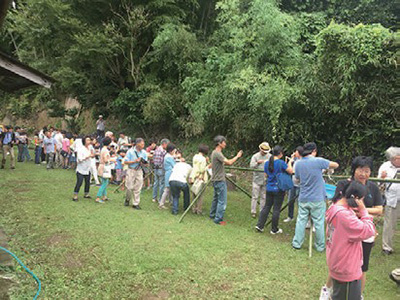
The Ichihara Future Workshop was held on August 19 and 20, 2015 in Ichihara, Chiba Prefecture. A middle-school pupil who participated in the Workshop suggested that We use bamboo that has been cut for Satoyama conservation, to make nagashi-somen noodles in Uchidamirai School, and by doing so, contribute to promoting the use of its local assets and enhancing community bonds in the region." The following year, this served as the basis for an event, "Nagashi Somen Summer - Ichihara Future Workshop Reunion 2016." On that day, the participants themselves made cups and chopsticks using bamboo, and boiled the somen in hot spring water boiled over firewood and kindling, and enjoyed nagashi somen.
Aiming for sustainability of local governments nationwide
In addition to facilitating policy formulation by various local govern-ments, it is hoped that the Future Chart will be employed as material in study workshops and other training programs for local officials and inhabitants, and as material in school education. It is also planned to contribute data for local issues like the vacant houses problem. Effort will furthermore be put into the development of facilitators, to stage Future Workshops. The Future Chart will develop together with the people.
First of all, we ask you to open up the Future Chart and have a look. What do you think your town will be like in 2040? Which capital bases do you think will need to be managed, and how, in order to change the future? The 1,791 local governments listed in the Excel Municipality code table for town/city/village will strive to flexibly deal with the declining and aging population, and evidence and hints to that end can be found in the chart.
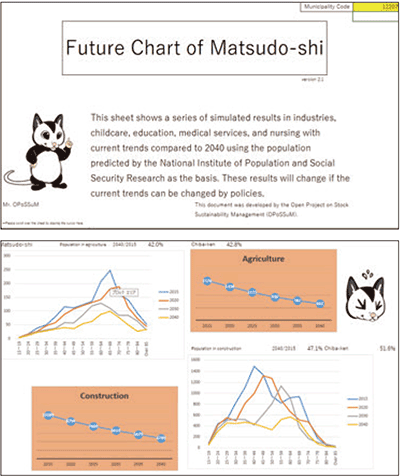
Example of Future Chart for Matsudo City
